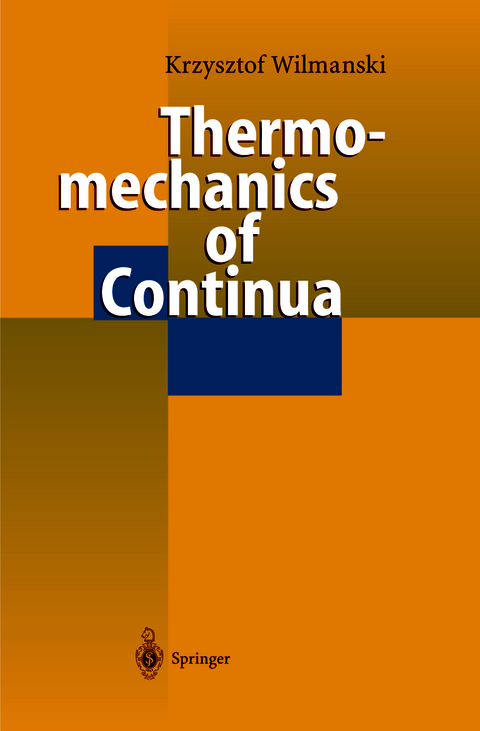
Thermomechanics of Continua
Springer Berlin (Verlag)
978-3-642-63797-1 (ISBN)
1 Introduction.- 1.1 Preliminary Remarks.- 1.2 Chains of Mass Points.- 1.3 Contents of the Book.- 2 Geometry.- 2.1 Reference and Current Configurations.- 2.2 Polar Decomposition of the Deformation Gradient.- 2.3 Some Other Measures of Deformation.- 3 Kinematics.- 3.1 Description of Motion.- 3.2 Time Changes of Some Geometric Objects.- 3.3 Change of the Reference Frame.- 4 Balance Equations.- 4.1 Preliminary Remarks.- 4.2 Global Balance Equations.- 4.3 Local Balance Equations.- 4.4 Local Conservation Laws.- 4.5 Spatial Form of Balance Equations.- 4.6 Spatial Form of the Local Conservation Laws.- 4.7 Conservation Laws in a Non-Inertial Frame of Reference.- 5 Structure of Field Equations.- 5.1 Introductory Remarks.- 5.2 Isotropic Functions.- 5.3 Galilean Invariance of Field Equations.- 6 Entropy Principle.- 6.1 Preliminary Remarks.- 6.2 Entropy Inequality.- 6.3 Hyperbolicity of Field Equations.- 6.4 Thermoelastic Materials with Mechanical Constraints.- 6.5 Solid Interfaces.- 7 Ideal Gase.- 7.1 Introduction.- 7.2 Galilean Invariance; Material Frame Indifference.- 7.3 Entropy Inequality.- 7.4 Hyperbolicity.- 8 Maxwellian Fluids; Viscoelastic Solids Part 1: Maxwellian Fluids.- 8.1 Background of the Models of Maxwellian Fluids.- 8.2 Constitutive Relations for a Non-Conducting Non-Newtonian Fluid; Field Equations.- 8.3 Entropy Principle.- 8.4 Thermodynamical Stability; Shear Pulses.- 8.5 Incompressibility; 2nd Grade Fluids.- 8.6 Field Equations in the Lagrangian Description.- 8.7 Second-Order Model of Isotropic Materials.- 8.8 Linear Viscoelastic Solids.- 9 Second Sound.- 9.1 Preliminary Remarks.- 9.2 Thermodynamical Model of the Phonon Gas.- 9.3 Four-Field Model.- 9.4 Thermal Waves.- 10 Some Multicomponent System.- 10.1 Introduction.- 10.2 Lagrangian Description.- 10.3 BalanceEquation for Porosity.- 10.4 Second Law of Thermodynamics for a Thermoelastic Skeleton and Ideal Fluid Components.- 10.5 Small Deviations from the Thermodynamical Equilibrium.- 10.6 Propagation of Plane Waves of Small Amplitude.- 10.7 Final Remarks.- Appendix A: Thermostatics.- Appendix B: Curvilinear Coordinates.- Appendix C: Hyperbolic Systems of PDE.- C.l. Preliminaries.- C.2. Single Equation of Two Independent Variables.- C.3. Set of Equations with Two Independent Variables.- C.4. Time of Existence of Classical Solutions.- C.5. Systems with Many Independent Variables.- References.
From the reviews
"The subjects presented in this book are treated accurately and specific results are derived which have appeared in the recent literature. Hence the book is recommended both for basic notions of thermomechanics of continua and for updated developments of some topics such as hyperbolicity of field equations, Maxwellian fluids, second sound, porous materials. The book is certainly useful for students and researchers in mathematics, physics and engineering." (Meccanica, 1999)
| Erscheint lt. Verlag | 28.10.2012 |
|---|---|
| Zusatzinfo | XI, 276 p. |
| Verlagsort | Berlin |
| Sprache | englisch |
| Maße | 155 x 235 mm |
| Gewicht | 445 g |
| Themenwelt | Naturwissenschaften ► Chemie ► Physikalische Chemie |
| Naturwissenschaften ► Physik / Astronomie ► Mechanik | |
| Technik ► Maschinenbau | |
| Schlagworte | Continuum Mechanics • Entropy • Fluid • Materials • Material Science • Mechanics • Nonlinear Thermodynamics • stability • Stress • Structure • thermodynamics • Thermomechanics |
| ISBN-10 | 3-642-63797-3 / 3642637973 |
| ISBN-13 | 978-3-642-63797-1 / 9783642637971 |
| Zustand | Neuware |
| Haben Sie eine Frage zum Produkt? |
aus dem Bereich


